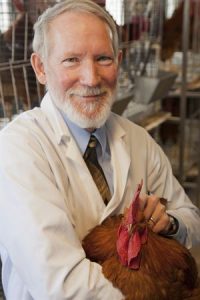Mark Cook’s UW animal research yielded patents
10.2.17 | Madison Magazine | Doug Moe

When Mark Cook died Sept. 9 from complications of cancer at the age of 61, there was a great outpouring of admiration and affection on the University of Wisconsin–Madison campus and beyond.
But as far as I could tell, nobody told the hairball story.
I never had the privilege of meeting Cook, a professor of animal sciences who shined as a teacher, researcher and entrepreneur, but I sure knew of him.
My wife, Jeanan Yasiri, has worked on campus in various roles across three decades, and called Cook one of the most inspired and inspiring faculty members she’d ever met.
I also know Maria Arendt, a recent graduate of the UW Veterinary School and a Ph.D. student in Cook’s lab.
Cook was a mentor, friend and colleague to Maria, who on several occasions took care of our mighty Pomeranian, Bobaloo, when we were traveling. Not long after Bobaloo died last year, we received a beautiful hardcover book containing numerous photos Maria had taken of Bobaloo, and a note: “Thanks for letting me care for him while you were away.”
That’s Maria.
Maria was excited to be working with Cook, whose research yielded dozens of patents, domestic and international. They shared a passion for researching chickens, not necessarily a first choice in the animal sciences. Indeed, Cook liked to call himself a “chickenologist.” Others called him, fondly, “that crazy chicken guy.”
Still, it was cats, not chickens, that produced one of Cook’s most enduring stories.
“I must have heard it 10 times,” Maria said, when we spoke last week.
You can hear Cook tell it himself on a podcast produced by Madison-based Flyover Labs.
Purina, the pet food company, hired Cook in the early 2000s as a consultant on pet care issues. He and company representatives talked on the phone once a month. Purina was mostly interested in the potential benefits of CLA—conjugated linoleic acid—in pet food. But at some point, on every call, Cook said they’d ask if he had any ideas about hairballs, which form after a cat grooms itself and are then coughed up.
“What’s a hairball?” Cook asked the first time the subject came up. Cats were not his forte.
“They all laughed,” Cook recalled in a 2003 interview, “and said, ‘It’s hair.’ So I said, ‘Put 20 of them in a box and ship them to me.’”
They arrived overnight in a Styrofoam case.
Cook and his colleagues analyzed the hairballs and found a high fat content. They put hairballs in two beakers with liquid to emulate the stomach, where hairballs get trapped. Cook squirted Dawn detergent in one beaker. Twenty minutes later, the hairball with the detergent had fallen apart. A food grade fat emulsifier, Cook realized, would accomplish the same thing.
He did a patent search for breaking down hairballs with emulsifiers, and, finding nothing, phoned an acquaintance at the Wisconsin Alumni Research Foundation, or WARF.
A month later, Cook said, he answered the call from Purina to the sound of giggling on the other end.
“What did you do with the hairballs?”
“Analyzed them,” Cook said.
The laughter stopped. Cook went on to explain his discovery, adding that Purina should call WARF if they wanted a license to the patent, which they did.
“They never talked to me again after that,” Cook said. “But they did license the patent and bring that product into the marketplace.”
The story epitomized Cook’s desire to turn research into products that can help make the world a better place—in this case, for cats and their owners.
“The hairball story showed how easy it can be,” Maria Arendt said.
While the hairball solution came quickly, others took years of painstaking work in the lab.
By all accounts, Cook loved his time there. Arendt said it wasn’t unusual to get a predawn email from Cook about something that needed to be accomplished in the lab.
Recently the lab has been working on a natural alternative to antibiotics for treating the most common diseases associated with poultry.
“Why chickens?” I asked Maria.
“I think for both Mark and me,” she said, “it was the possibility to feed the world and the potential that chickens have as a source of protein for people.”
Cook, a Louisiana native, loved animals as a kid, and worked on his uncle’s dairy farm. His wife Ellen was his high school sweetheart. They came to Madison in 1982, when Mark took a position at UW.
I can only wonder how many people he touched with his energy, humor and vision over his 35 years on campus. I know there must be many like my friend Maria. Mark Cook changed her life.
She remembers one particularly tough day at vet school, after which she came into Cook’s office and said she’d had it; she was quitting the school to work exclusively in Cook’s lab.
Cook heard her out, even agreed in part, but then said, “You need to finish. It will be well worth it. Stick it out.”
She did.
Before Maria left that day, Cook reminded her of the money she’d make as both a veterinarian and a Ph.D.
“You’ll have to buy me a big car,” he said.